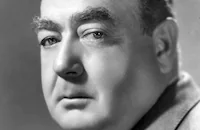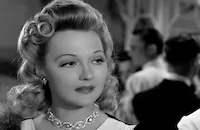Stowaway

Brief Synopsis
Cast & Crew
William A. Seiter
Shirley Temple
Robert Young
Alice Faye
Eugene Pallette
Helen Westley
Film Details
Technical Specs

Synopsis
Sun Lo, the magistrate of Sanchow, China, begs Alfred Kruikshank and his wife to send their young ward Ching-Ching to safety when the village is invaded by bandits. Kruikshank refuses, even though Ching-Ching's parents were killed in a similar uprising. Sun Lo disobeys Kruikshank and sends her to Shanghai with his brother Chang, who steals her money and deserts her. After leaving Chang's boat in search of food, Ching-Ching translates for American tourist Tommy Randall as he purchases a souvenir, and the rake is charmed by her. Tommy takes her to meet his friends, with whom he is to sail that night, but when he leaves her to wait in his car, she runs after her dog when he chases a cat. Upon finding her gone, Tommy is disappointed and leaves to get drunk. Ching-Ching returns, climbs into the rumble seat to avoid the rain and falls asleep before the car is loaded onto the ship. The next morning, the frightened stowaway hides in the cabin of Susan Parker and Mrs. Hope, who are traveling to Bangkok to meet Richard Hope, Mrs. Hope's son and Susan's fiancé. Because of Tommy's playboy reputation, Susan becomes the child's temporary guardian. Tommy and Susan are attracted to each other, and soon Mrs. Hope catches him kissing her. Concerned, Mrs. Hope wires Richard to meet them ahead of schedule. One afternoon, Tommy, Susan and Ching-Ching go ashore at Hong Kong and attend a vaudeville show. Afterward, Tommy carries Susan across a muddy street just as Richard and Mrs. Hope walk by. The Hopes and Susan return to the ship, while Tommy and Ching-Ching visit a tapestry shop, where Tommy accidentally takes another child's hand, and consequently is jailed with Ching-Ching for kidnapping. The ship's captain bails them out, but Susan sees Tommy helping his drunken friends on the ship and assumes the worst. After the captain receives word that Ching-Ching must be sent to a missionary girls' home in Shanghai, Tommy is crushed to find out that, being a bachelor, he cannot adopt her. He asks Susan to adopt her with Richard, which she agrees to do. However, when Richard and his mother forbid the adoption, Susan breaks her engagement. Tommy and Susan marry in order to adopt the waif, but agree that the marriage will be in name only. When Susan goes to Reno for a divorce, Tommy tries to prove he has changed, but Susan is unswayed and becomes engaged again to Richard. Ching-Ching and Judge Booth conspire to trick Susan and Tommy into admitting they love each other, and the divorce is denied. Later, Ching-Ching sings to her new parents in front of their Christmas tree.

Director

William A. Seiter
Cast

Shirley Temple

Robert Young

Alice Faye

Eugene Pallette

Helen Westley

Arthur Treacher
Allan Lane

J. Edward Bromberg

Astrid Allwyn
Robert Greig
Jayne Regan
Julius Tannen
Willie Fung
Philip Ahn
Paul Mcvey
Helen Jerome Eddy
William Stack
Honorable Wu
Crew
Harry Brand
Irving Caesar
Earl Carroll
William Conselman
William Darling
B. G. Desylva
Samuel G. Engel
Mack Gordon
Eugene Grossman
Earl Haley
Bert Hall
Roger Heman
Thomas Little
Arthur Miller
Lloyd Nosler
Nat Perrin
Harry Revel
Royer
Arthur Sheekman
Richard Sherman
Louis Silvers
Harold Wilson
Tommy Wonder
Darryl F. Zanuck

Videos
Movie Clip





Film Details
Technical Specs

Articles
Stowaway
Though her grown up costars (by this point, Gary Cooper, Lionel Barrymore, Janet Gaynor, Ginger Rogers, Adolphe Menjou) carped to the press about having had to play second fiddle to someone who could not even tie her own shoes, the balance sheet settled all arguments. Made for $200,000-300,000, Temple's films grossed well over a million each in their first run releases (with considerably more to be made in second run houses and in European rentals). By 1936, Temple was a seasoned professional who came to the set each day with her dialogue and stage directions memorized and expecting her costars to honor the same level of professionalism. During production of Stowaway, Temple's ordinarily infallible recall of her own dialogue seemed to falter for the first time in a scene played opposite Broadway veteran Helen Westley... until Westley realized that the only reason Temple had gone up on her lines was because she herself had left out a large chunk of the text. In preparation for her role, Temple learned over one hundred phrases in Mandarin ... an accomplishment that failed to impress the production's army of Chinese-American extras, most of whom spoke only Cantonese.
Leading lady Alice Faye was making her third film with Temple but coming into her own after years of toiling in the shadow of Jean Harlow. When Faye contracted influenza during principal photography, production of Stowaway shut down for two weeks... a delay that did not sit well with Temple. Though the 8 year-old star resented Faye for falling sick, a sense of empathy came when she herself got the flu, requiring another two week postponement. Temple also lost a back tooth during production, which caused an annoying whistle during the film's production numbers. Otherwise, Stowaway afforded her plenty of show stopping moments, including a pantomime Fred Astaire/Ginger Rogers dance (with a dummy playing the Astaire part) and Temple's mimicking of Al Jolson singing "Mammy." By report, Temple was slightly unnerved by having to study Jolson's singing for the scene. "Watching and listening to him made me wince," she admitted in her 1988 memoirs.
Stowaway was another hit for 20th Century Fox and for Temple, whose signature roles lay ahead of her in Wee Willie Winkie (1937), Heidi (1937), and Rebecca of Sunnybrook Farm (1938). That she seemed not to be maturing physically was less of a concern for 20th Century Fox executives (whose corporate income was 90% attributable to Temple) than it was for her mother, Gertrude. Worried that her daughter's stocky legs and rounded middle would doom her to a future of obesity, Gertrude Temple consulted a physician about injections of pituitary extracts to stimulate leg growth. Luckily, no such alchemy was needed when Temple spontaneously began maturing on her own - a development that would have a deleterious effect on her film career. Fox handler Darryl F. Zanuck famously refused to loan Temple to MGM for The Wizard of Oz (1939), preferring to retain his star for The Blue Bird (1940). The failure of that enterprise prompted Temple's parents to buy out the remainder of her contract. As a freelancer, Temple had only moderate success and retired from motion pictures in 1949, at the age of 21.
By Richard Harland Smith
Sources:
Shirley Temple by Lois Eby (Monarch Books, 1962)
Shirley Temple: American Princess by Anne Edwards (William Morrow & Co., 1988)
The Films of Shirley Temple by Robert Windeler (Citadel Press, 1978)
Child Star, An Autobiography by Shirley Temple Black (McGraw-Hill Publishers, 1988)
The Shirley Temple Story by Lester David and Irene David (GP Putnam &Sons, 1983)
The Shirley Temple Scrapbook by Loraine Burdick (Jonathan David Publishers, Inc., 2003)
Shirley Temple by Jeanine Basinger: Pyramid Illustrated History of the Movies (Pyramid Publishers, 1975)
Alice Faye: A Life Beyond the Silver Screen by Jane Lenz Elder (University Press of Mississippi, 2002)
The Films of Alice Faye by W. Franklyn Moshier (W. Franklyn Moshier, 1972)
Alice Faye: A Bio-Bibliography by Barry Rivadue (Greenwood Press, 1990)

Stowaway
Quotes
Trivia
Notes
Robert Young was borrowed from M-G-M for this film. According to a press release, dancer Tommy Wonder created the "rag doll dance," during which a performer dances with a life-sized rag doll, and he taught Shirley Temple how to do the dance. She uses his technique in the vaudeville section of this film, in which she dances with a male dummy and imitates Fred Astaire and Ginger Rogers. She also imitates Al Jolson and Eddie Cantor in this sequence. Honorable Wu's character, called "Li Ze Mon" in the film, is called "Latchee Lee" in some contemporary and modern sources. A March 16, 1939 Hollywood Reporter news item reported that Stephen Tamas filed a lawsuit against Twentieth Century-Fox, in which he claimed Fox had plagiarized a scenario that he had written for Temple and submitted to them in March 1936. According to Temple's autobiography, Joan Storm Dezendorf, who alleged that story writer Sam Engel had plagiarized one of her stories, also filed a lawsuit against Twentieth-Century Fox. In addition, Temple notes that Charles McCord accused songwriters Mack Gordon and Harry Revel of plagiarizing "Goodnight My Love" from one of his songs, and that Juan Calaby made a similar claim, saying that the song was taken from his song "Señorita." No other information about these lawsuits has been found. Temple also states that Bessie Nyi, a student from Shanghai, taught her "several hundred Chinese phrases," in the "Mandarin dialect of North China."














